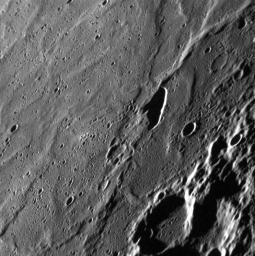The Tolstoj basin is located in Mercury's southern hemisphere, and is 355 km (220 miles) in diameter. This oblique image shows an elongate pit inside Tolstoj, a basin whose floor appears to have been flooded by lavas. The pit lacks the raised rim of an impact crater, and may have formed when magma withdrew from a shallow chamber, causing an unsupported area of the surface to collapse. The low-angle lighting in this image hides the floor of the pit, making it appear much deeper than it actually is. The pit is aligned approximately north-south.
This image was acquired as a high-resolution targeted observation. Targeted observations are images of a small area on Mercury's surface at resolutions much higher than the 250-meter/pixel (820 feet/pixel) morphology base map or the 1-kilometer/pixel (0.6 miles/pixel) color base map. It is not possible to cover all of Mercury's surface at this high resolution during MESSENGER's one-year mission, but several areas of high scientific interest are generally imaged in this mode each week.
Date acquired: January 11, 2012
Image Mission Elapsed Time (MET): 234752446
Image ID: 1251011
Instrument: Narrow Angle Camera (NAC) of the Mercury Dual Imaging System (MDIS)
Center Latitude: -16.97°
Center Longitude: 198.1° E
Resolution: 99 meters/pixel
Scale: This image shows a field of view approximately 150 km (93 miles) across
Incidence Angle: 84.8°
Emission Angle: 58.6°
Phase Angle: 135.6°
The MESSENGER spacecraft is the first ever to orbit the planet Mercury, and the spacecraft's seven scientific instruments and radio science investigation are unraveling the history and evolution of the Solar System's innermost planet. Visit the Why Mercury? section of this website to learn more about the key science questions that the MESSENGER mission is addressing. During the one-year primary mission, MDIS is scheduled to acquire more than 75,000 images in support of MESSENGER's science goals.
These images are from MESSENGER, a NASA Discovery mission to conduct the first orbital study of the innermost planet, Mercury. For information regarding the use of images, see the MESSENGER image use policy.

 Planetary Data System
Planetary Data System












